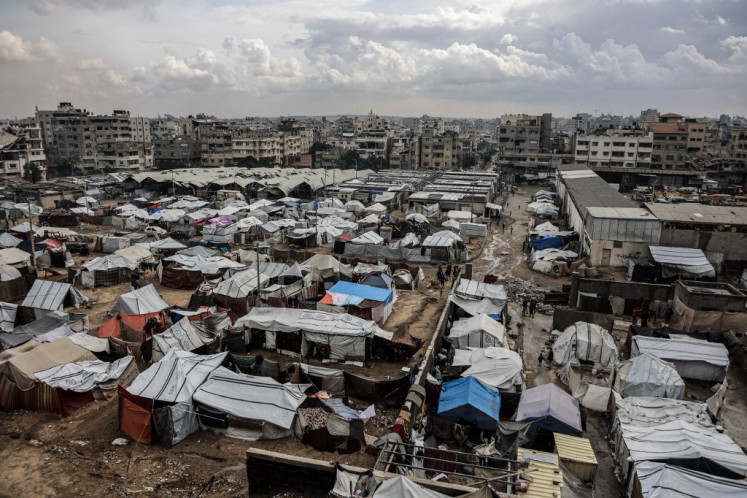Popular Reads
Top Results
Can't find what you're looking for?
View all search resultsPopular Reads
Top Results
Can't find what you're looking for?
View all search resultsClass struggle and children’s long-distance learning
The majority of pupils surveyed do not enjoy PJJ and want to return to ordinary classroom.
Change text size
Gift Premium Articles
to Anyone
M
any have complained of gaining weight during the current pandemic, due to staying at home and having the munchies. Well, there is one way to avoid that: have school age kids who are engaged in long-distance learning (Pembelajaran Jarak Jauh, PJJ).
That is the experience of “Umi”, a mother with an 11-year-old son, “Tomi” in the sixth grade. Already thin, she has gotten skinnier since they followed the PJJ instruction from the Education and Culture Ministry, while Tomi has gotten chubbier and chubbier.
The morning starts with roll call at 6:30, taking a photo of Tomi in his school uniform. Later this is followed by various assignments: a video of Tomi making fried rice for breakfast, written assignments, or making things. Sometimes it involves getting materials, like when Tomi had to make plasticine. Umi had to rush to the store to buy food coloring as they had to make the plasticine in five colors.
For physical education (PE) class, Umi had to record Tomi dribbling a basketball 50 times alternately with his right and left hands, throwing the ball at a wall 50 times, and dribbling back and forth with his left and right hand 10 times. Seems simple enough, right? Except that the basketball was flat. No pump at home, so again Umi had to rush to the nearest place where she could get the basketball inflated.
Umi says that virtually – no pun intended! – everything the kids are required to do from school requires the involvement of parents. The good thing of course is that this hands-on approach makes the parents closer to their kids, but it also comes at a price. Even for a full-time mom it’s already tough, what about working mothers?
Umi is a single mother, who also has an elderly sick mom to take care of, and limited income as she only works part time.
Another mother, “Yesi”, also has lost weight since the inception of PJJ. She has three daughters, the twins are 12 in the second class of secondary high school, while the youngest, 7, is in the third grade of elementary school. Yesi is a working mum, but luckily the father of the kids also helps. Both work from home, so they have a lot of juggling to do.
Yesi had to learn physics, biology and mathematics again, so she could teach the kids. Initially they only had one laptop and not enough table space. They ended up having to buy three laptops with headphones, two desks and three chairs.
Apart from the obvious challenges, both Umi and Yesi said there were plus points to the online learning. There was more three-way interaction between the pupils, parents and teachers which had not existed before. The lessons were more focused and selective, there was less use of paper, and even the school admin was simpler.
Umi and Yesi both belong to the middle class. In fact Yesi’s family have the ideal profile to adapt to the PJJ. They could easily afford to buy new laptops, extra desks and tables, have the infrastructure (house space, car, etc) and both are working parents who collaborate and coordinate well, are organized and have the educational level and capacity to teach their kids at home.
What about the multitude of other families in Indonesia who are a far cry from Yesi’s family?
The Commission for the Protection of Indonesian Children (KPAI) published a 20-page report on June 27 about the effects of the PJJ implementation. The respondents consisted of 1,700 pupils and 575 teachers from kindergarten to high school level covering 20 provinces and 54 regencies/cities. The occupation of the parents were mainly from the middle to lower classes: daily workers from the informal sector to civil servants.
The majority (95.4 percent) used smartphones, 23.9 percent used laptops while 2.4 percent used desktops. About 46.4 percent had Wi-Fi, while 53.6 percent did not. 43.1 percent knew about the free learning platform “Rumah Belajar” (https://belajar.kemdikbud.go.id/) for pupils from kindergarten to high school, while 56.9 percent did not. Regarding interaction between pupils and teachers, 20.1 percent of respondents said there was interaction, while 79.9 percent said there was none, or only limited to giving tasks and simply asking pupils to return the completed tasks.
Of the 1,700 respondents, 77.8 percent said that assignments piled up as the teachers gave the assignments at very short notice; 37.1 percent complained about the very short time to complete the assignments which sapped their energy as they did not have enough time to rest. Around 42.2 percent did not have sufficient internet quota, while 15.6 percent did not have adequate PJJ tools such as a smartphone or laptop that supports online learning.
These are just a few of the results that appear on the KPAI survey, which are enough to show the challenges that the majority of families would have to face with PJJ. In conclusion, the majority of pupils surveyed do not enjoy PJJ and want to return to ordinary classroom learning (see “Pak Nadiem, please send the kids back to school”, The Jakarta Post, July 23).
Predictions about the medium and long term effects of PJJ include the mental health of the child, demotivation of teachers and school bankruptcy. These are already pretty devastating and possibly irreversible.
Can we afford to sacrifice Indonesia’s children to this ongoing “class struggle”?
***
The writer is the author of Julia’s Jihad.










